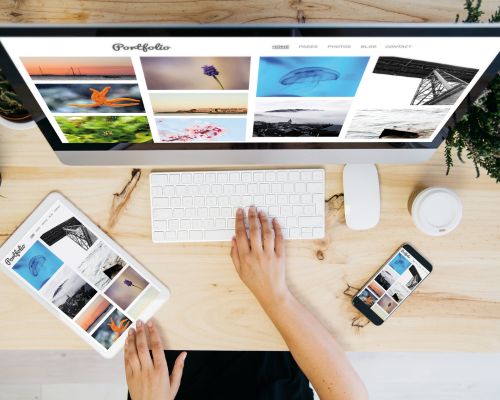How To Make An Art Portfolio (In 10 Easy Steps)
Are you an artist who wants to create a successful and profitable business online? Then it would help if you learned how to make an art portfolio – there is no way around that.
A successful art portfolio is a dynamic representation of your artistic journey. As such, you should tailor it to your goals, continually refine it, and let your creativity and skill shine through.
More importantly, your art portfolio must reveal who you are as an artist and convince potential buyers why you’re the best person they could ever work with. But how do you achieve all that?
In this article, I’ll walk you through the process of creating a professional art portfolio from start to finish. Additionally, I’ll provide you with tips and ideas to make your art portfolio effective and memorable.
Recommended Read:
- What Art Sells Best?
- How To Market Yourself As An Artist
- 10 Ways To Promote Your Art
- 20 Best Passive Income Ideas For Artists
- Make Money Selling Digital Art Online
What Is An Art Portfolio?

Generally speaking, an art portfolio is a collection of the best artwork you’re preparing to showcase to potential clients. An art portfolio can be in a physical or digital form. Considering you’re trying to attract art buyers on the web, we’ll concentrate on the second option:
Your digital portfolio should contain 10-20 pieces of artwork that best represent your artistic abilities. Moreover, your art portfolio must reflect who you are as an artist and the type of brand you’re building to show to the world.
Overall, creating an online portfolio is a crucial moment for every artist. It will serve as a comprehensive collection of your work, showcasing your skills, creativity, and style.
Why Creating An Art Portfolio Is Important?
Whether you’re an aspiring artist or a seasoned professional, having an art portfolio is crucial for several reasons. Let’s look at them, shall we?
- Professional Presentation: For artists seeking opportunities such as exhibitions, commissions, or employment in creative fields, a well-curated portfolio is essential. It acts as a professional resume, showcasing an artist’s capabilities to potential clients, galleries, or employers.
- Self-Reflection and Improvement: Compiling a portfolio involves selecting the best pieces of artwork. This process encourages self-reflection, enabling artists to critically evaluate their work, identify strengths and weaknesses, and strategize for improvement.
- Documentation and Progress Tracking: An art portfolio serves as a documented history of an artist’s progress over time. It can include earlier works alongside recent ones, showcasing development, experimentation, and growth in skills and artistic vision.
- Establishing an Artistic Identity: A portfolio helps in defining an artist’s unique style and aesthetic. Consistent themes, techniques, or visual elements across the portfolio can contribute to establishing a recognizable artistic identity.
- Networking and Promotion: Artists often use portfolios to network and promote their work. Whether online through social media platforms, a personal website, or physical copies shared during events or meetings, portfolios help artists gain exposure and attract potential collaborators or patrons.
- Client Communication: When working with clients or potential buyers, an art portfolio becomes a valuable tool for communicating ideas, preferences, and possibilities. It helps clients understand an artist’s capabilities and vision, facilitating smoother collaborations.
How To Make An Art Portfolio: Step-By-Step Guide
1) Define Your Goals

As you can probably guess, the first step to making an art portfolio is creating a vision that will guide you through the process. What are you hoping your portfolio to achieve? Who will that portfolio serve?
Are you aiming for admission to art school, seeking representation, applying for specific jobs, or showcasing your work to potential clients? More importantly, who is the target audience your art portfolio should reach?
Understanding your goals will help you tailor your portfolio accordingly. Besides, it will make the creation process much easier.
2) Select Your Best Work
The next step in the creation process of your art portfolio is to choose your best artwork. But how do you do that? How do you decide which artwork should be in your online portfolio?
Here are a couple of things to keep in mind when selecting artwork for your portfolio:
- Quality is key. Choose artwork that reflects your technical skill, creativity, and artistic voice. Aim for a cohesive collection that highlights your strengths and versatility.
- Consider diversity in style, medium, subject matter, and technique to showcase your range as an artist.
3) Organize And Curate Your Portfolio
Picking your best art pieces is not enough to leave a lasting impression. Considering you’re still learning how to make an art portfolio, let me show you how to deal with the work you have chosen:
- Ensure a strong opening piece that captures attention and entices viewers to explore further. Arrange your artwork strategically to maintain interest throughout.
- Establish a narrative flow within your portfolio. Create sections or categories that make sense, considering themes, mediums, or chronological order.
4) Photograph (Or Digitize) Your Work
- Use a high-quality camera or scanner to capture images of your artwork. Ensure proper lighting, minimal glare, and accurate color representation.
- Edit photos using software like Adobe Photoshop or Lightroom to adjust colors, remove background distractions, and optimize image quality while staying true to the original artwork.
5) Create A Digital Portfolio

Have you completed the previous steps? Great, now it’s time to bring your digital art portfolio to life:
- Choose a platform that suits your needs and showcases your work effectively. Customizable portfolio websites or platforms offer templates and customization options to display your art professionally.
- Ensure your portfolio website is mobile-responsive, easy to navigate, and loads quickly.
Include A Variety Of Content
- Incorporate sketches, studies, and work-in-progress shots to demonstrate your creative process. This provides insight into your artistic development, problem-solving skills, and dedication to your craft.
- Balance these preliminary works with finalized pieces to showcase your progression from concept to completion.
6) Write A Description For Each Artwork
If you want to know how to make an art portfolio that potential buyers won’t easily forget, I’ll tell you how to achieve that:
No matter what, make sure each artwork comes with an in-depth description. So, craft concise yet compelling artist statements for each artwork.
Don’t forget to mention the inspiration, concept, techniques used and any significant details that enhance the viewer’s understanding of your work. Meanwhile, Keep descriptions clear, engaging, and relevant. Avoid jargon that might alienate those unfamiliar with art terminology.
7) Put Effort In Presentation
Each artist trying to build a successful business online should aim to create the best art portfolio possible. Since you’re in a visual industry, it won’t come as a surprise that presentation is everything:
For physical portfolios, invest in a high-quality case or binder that protects your artwork. Use acid-free paper or archival sleeves to prevent damage over time.
More importantly, pay attention to the layout and arrangement of your artwork within the portfolio – you want a clean and organized presentation.
8) Update Your Portfolio Regularly
You may want to believe that once you know how to make an art portfolio and complete the steps above, your work is done, but that’s not true:
On the contrary, you must add new pieces from time to time to keep your portfolio fresh and reflective of your current skills and style. Naturally, you should also remove older or weaker pieces that no longer align with your artistic direction or proficiency.
9) Prepare For Presentations
- Practice presenting your portfolio confidently.
- Be ready to discuss your artistic choices, techniques, influences, and artistic journey.
- Tailor your presentation to your audience, adapting your language and depth of explanation accordingly.
10) Add Finishing Touches
- Proofread all written content thoroughly for spelling, grammar, and clarity.
- Review the overall layout, image quality, and functionality of your digital portfolio before sharing or presenting it to ensure a professional and polished presentation.
Tips And Ideas For Creating A Successful Art Portfolio
Make Sure Your Art Portfolio Tells A Story
Storytelling is one of the most effective strategies you can implement while building an art business. How can you incorporate storytelling into your art portfolio?
Well, you can organize your portfolio in a way that creates a narrative or flow. Consider grouping artwork by themes, series, or chronological order to guide the viewer through your artistic journey.
Highlight Process And Development
Do you know what can help you a lot while you’re still working on the process of how to make an art portfolio? I’ll let you in on the secret:
Potential buyers will connect with your art pieces better if they can witness the process of them coming to life. Show them sketches, studies, or work-in-progress shots alongside finished pieces. This provides insight into your creative process and demonstrates your growth as an artist.
Quality Over Quantity
By all means, select your best and most relevant work to include in your art portfolio. Focus on showcasing a cohesive collection that demonstrates your skills, style, and artistic vision rather than including too many pieces.
Ultimately, don’t forget about diversity – include a variety of mediums, styles, subjects, and techniques in your portfolio.
Consistency Is The Key To Success
While diversity is important, ensure there’s a consistent level of quality and style throughout your portfolio. Your work should feel cohesive and representative of your unique artistic voice.
Be Professional And Engaging
Showcase your passion for art and professionalism throughout your portfolio. Engage viewers with your unique perspective and creativity.
Adapt To Your Audience
Lastly, tailor your portfolio to the specific audience or purpose. For example, if applying to a specific art school or seeking gallery representation, consider what they look for and adjust your portfolio accordingly.
How To Make An Art Portfolio: Final Say
Well, this is it for today – you can see the entire process of creating an art portfolio above. By all means, don’t skip any of the steps:
While creating a professional art portfolio takes time and effort, the process is unavoidable if you want to build a profitable art business from scratch.
What questions do you have about this topic? Is there something you don’t understand?
Let me know in the comments section below, and I’ll get back to you as soon as possible.
Related Articles: